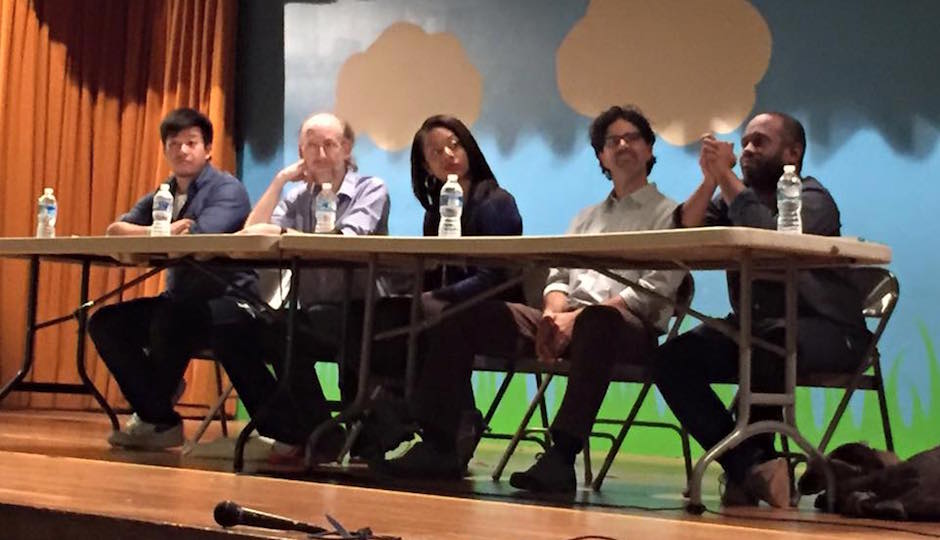Philly Mag Cover Criticized at Second Event This Week

From L to R: Panelists Wei Chen, Paul Socolar, Cherri Gregg, Josh Block and Tayyib Smith. | Photo courtesy of Ben Waxman
For the second time this week, the widely criticized cover of Philadelphia magazine’s October issue was a major topic of discussion at a roundtable event.
The cover, headlined “A City Parent’s Guide to Schools: How To Get Your Kid a Great Education … Without Moving to the ‘Burbs,” features a photograph of seven Greenfield Elementary students, none of whom are African-American. The student body is 32 percent black; the School District of Philadelphia is 52 percent black.
“Teachable Moments: A Conversation About Race and Education in Philadelphia” was hosted at Greenfield Elementary School on Thursday by the Friends of Greenfield and Greenfield Home and School Association. At the event, parents, administrators and former students at the school, as well as the roundtable’s panelists, expressed outrage at the cover.
Dineth Allen is the mother of a sixth-grade boy at Greenfield. She said that when he saw the cover, her son said, “I felt like Greenfield wasn’t proud of me.”
Greenfield principal Daniel Lazar said the cover did not represent the school, which is well known for its diverse student population.
“It was a disservice to our community,” he said. “It’s not a reflection of who we are.”
Panelist Tayyib Smith, founder of Little Giant Creative and publisher of two.one.five magazine, said the October cover, as well as the magazine’s 2013 cover story “Being White in Philly,” are “nothing short of white supremacy.” The 2013 article was roundly criticized by journalists, community members and elected officials.
The Philadelphia Association of Black Journalists, which is headed by KYW reporter Cherri Gregg, who was also a panelist at Thursday’s event, has called for the resignation of editor-in-chief Tom McGrath.
McGrath apologized for the cover shortly after the publication of October’s issue. He wrote in a letter to PABJ earlier this month that he has no plans to resign and will “stay and make the changes” needed to diversify the company’s staff. Metro Corp., the parent company of Philadelphia and Boston magazines, released a new diversity policy this month.
Gregg stressed the importance of having a diverse newsroom, saying it can help to avoid “big blind spots” in coverage. She said Philadelphia magazine made promises to diversify its staff after the publication of “Being White in Philly,” but failed to keep them.
Smith was skeptical that anything more than minor changes would be made at the magazine in the wake of the cover, and he said he expected that community members would be discussing another Philadelphia magazine controversy in short order. He also spoke about the publication’s responsibility to the city: “When your name is Philadelphia magazine … you are going to be held to a higher moral compass,” he said.
Organizers said about 80 people attended the Thursday event.
In addition to the magazine’s cover, the panelists discussed the lack of equity for black schoolchildren in the School District of Philadelphia, the impact of segregation in schools and the region, and the concentration of poverty in the city, among other topics.
Paul Socolar, editor and co-founder of the Philadelphia Public School Notebook, noted that inequity has long been a problem in city schools. He read from the first issue of the Notebook, which was published in 1994. It featured an article about a decision by then-Commonwealth Court Judge Doris Smith, which detailed inequality in the school system.
Judge Smith said students in “racially isolated minority schools” get “less experienced and less highly rated teachers, older school buildings requiring greater repair, fewer dollars spent on educational improvement, and limited opportunities for minority students to attend magnet schools.”
The same issues plague the school district today, Socolar said.


